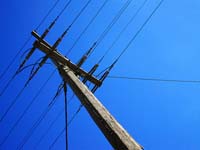WiMax aces Energy Australia trial

A WiMax trial Energy Australia has been running with Alcatel-Lucent in the Newcastle region has come up trumps, with early results being much better than expected.

(Credit: Powerline Tracks
by visualdensity, CC2.0)
The $3 million, six-site trial was intended to test the technology over an area of 100,000 customers and to see if signal strengths were adequate for communicating machine-to-machine with network components and smart meters.
The organisation planned to have carried out 20,000 signal strength tests by June this year, but the project is ahead of schedule, with 13,000 tests already done since the network was commissioned in October. The success rate has until now been over 99 per cent. "Definitely much better than expected," Energy Australia manager intelligent networks Adrian Clark told ZDNet.com.au. recently.
With a network of sensors and meters connected via WiMax, Energy Australia would be able to respond to outages more quickly, run its network in a more efficient and automated fashion, give customers real-time information about their electricity use and enable field computing for staff.
"We identified WiMax as a fourth generation technology — one which we could actually pilot today," Clark said. Other options the company considered were 2G, proprietary wireless technology, 3G or even narrowband over power line.
"A lot of our work has been looking at those, but we see some of them will be obsolete in a few years," Clark said. The units making up the energy network have a 15-year minimum lifespan. Replacing equipment every two to three years wasn't an option, he said, meaning a longer-term technology was needed.
WiMax offered not only that, but a variety of vendors, which meant that Energy Australia would not find itself married to any one company down the line, he said.
Using 3G would support the requirements, he said, but Energy Australia would need millions of devices with low bandwidth requirements on one base station. The 3G networks built today hadn't been designed with that in mind, Clark said, adding that there weren't any devices ready at this point. WiMax on the other hand had a number of different vendor roadmaps for devices.
Despite this reasoning, Energy Australia wasn't "100 per cent wedded to WiMax" Clark said, adding that the company saw WiMax and LTE as "at least being technically similar". The utility could fall back on 3G networks and wait until smart meters were better defined, he said.
Yet a strategic decision on the preferred communications platform needed to be made and would be tackled after the trial was over, he said.
When the roadmap was clear, Energy Australia would then be able to proactively roll out compliant equipment as it was needed. The utility had already earmarked over $8 billion for the replacement of network components over the next five years, making now a good time to make the strategic decision, Clark said.
Another hurdle the utility needs to overcome before any roll-out can go ahead is to get its hands on some spectrum. The spectrum it had been using for the pilot had only been granted on trial basis. The options, Clark said, were to buy some from a carrier or to approach ACMA to have some released for the purpose. Energy Australia had been in preliminary discussions with carriers, he said. The utility would need around 15MHz of spectrum.